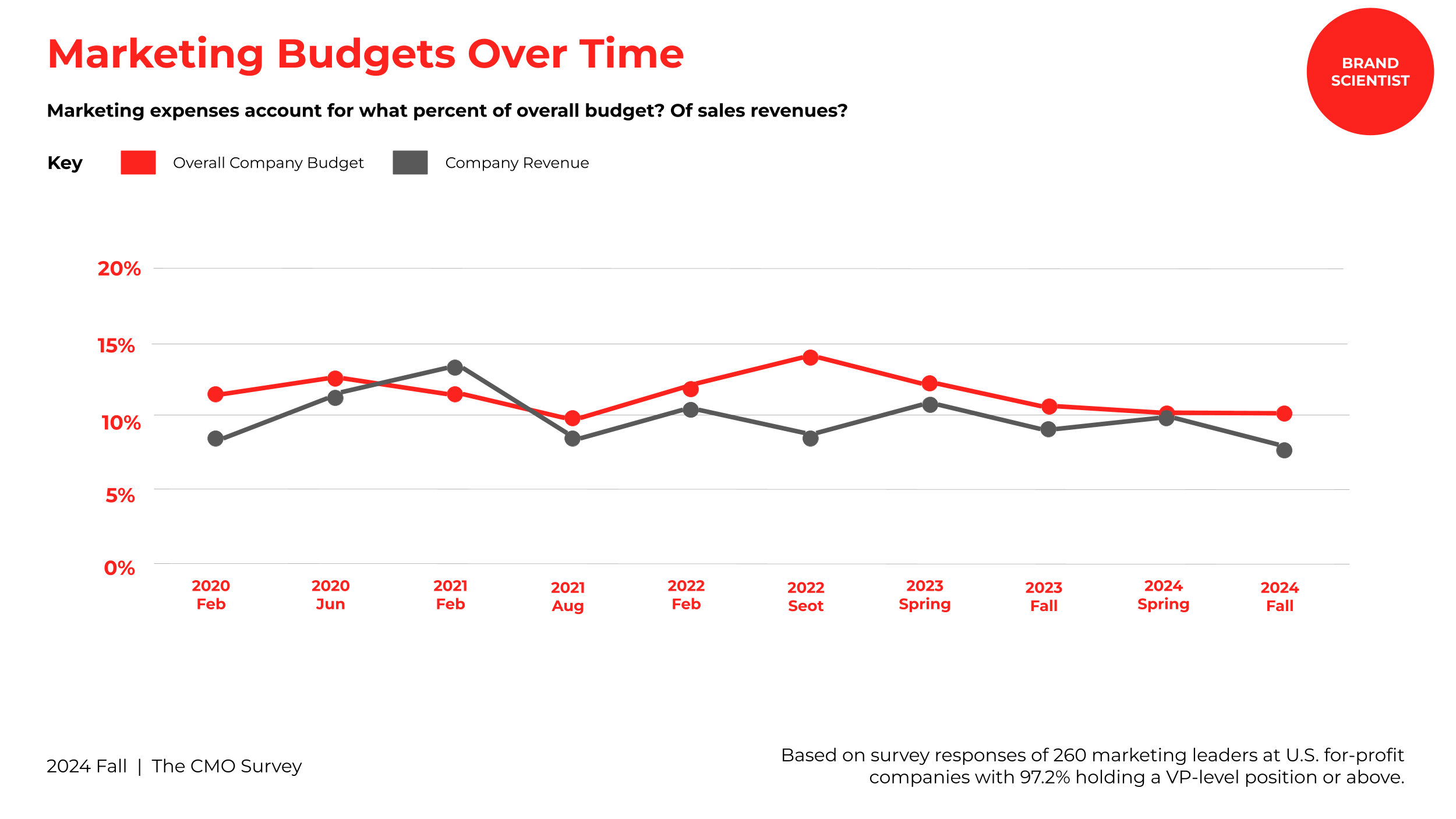How Does Company Revenue Influence Marketing Budgets?
Marketing budgets, according to The CMO Survey, continue to shrink as a percentage of overall company budgets, dropping to 10.1% in Fall 2024, a significant decline from the three-year peak of 13.8% in September 2022. Similarly, marketing budgets as a percentage of company revenues also fell, reaching a low of 7.7% in Fall 2024, compared to 10.1% in Spring 2024. This indicates a growing trend of companies allocating fewer resources proportionally to marketing, possibly due to economic uncertainties or shifting business priorities.
Despite these budget reductions, actual marketing spending has increased, particularly in digital marketing, which rose by over 3% year-over-year to 11.1% of total spend. Marketers project a 12.7% increase in spending over the next year, which is notably higher than the 5.8% growth in Fall 2024. Investment in customer relationship management, customer experience, branding, and product/service introductions is set to rise as companies prioritize engagement and growth in competitive markets. Even traditional advertising, which has been in decline for years, experienced a modest 0.8% growth, marking a rare uptick in the industry. Social media spending, however, only increased by 1% over the last six months, now accounting for 12.1% of marketing budgets.
One of the biggest challenges marketers face is balancing short-term performance marketing with long-term brand building. While marketers ideally aim for a 50/50 split between the two, the reality is a heavy lean toward short-term performance marketing, with 68.8% of budgets allocated to immediate results and only 31.2% for brand-building efforts. Additionally, companies are spending 19.6% more on customer acquisition than retention, signaling a preference for growth over sustainability. However, this imbalance may pose risks in customer loyalty and long-term profitability.
Marketing teams also face increasing pressure to justify their budgets, as companies are 5.8% more likely to cut expenses than focus on revenue growth. In nearly half (44.6%) of cases, executives opt to cut marketing costs before other areas, making it more difficult for marketers to advocate for increased investments. As a result, marketers must strategically allocate resources, demonstrate clear ROI, and focus on cost-efficient strategies to maintain their budgets and continue driving growth.
Key Actionable Takeaways:
Justify ROI Clearly – With marketing budgets under scrutiny, focus on demonstrating clear returns on investment (ROI) through data-driven reports and analytics.
Prioritize Customer Retention – Since companies are over-investing in customer acquisition, marketers should advocate for stronger retention strategies to improve lifetime customer value.
Balance Short-Term and Long-Term Strategies – Push for a more balanced marketing budget that invests adequately in brand-building to ensure sustainable growth.
Optimize Digital Spending – With digital marketing growing, focus on maximizing effectiveness through performance tracking, AI-driven insights, and automation.
Leverage Traditional Advertising Wisely – The slight resurgence in traditional advertising suggests an opportunity to integrate it strategically with digital efforts for greater impact.
Enhance Customer Experience (CX) – Since spending on CX is increasing, develop marketing strategies that improve engagement, personalization, and loyalty programs.
Advocate for Budget Protection – Given that marketing is often the first cost-cutting target, prepare strong business cases that link marketing efforts to revenue growth.
Focus on High-Impact Channels – With social media growth slowing, reassess platform effectiveness and consider diversifying into emerging channels or content-driven marketing.
Invest in Product and Service Launches – With increased spending projected for new product and service introductions, align marketing strategies to support these initiatives effectively.
Monitor Industry Spending Trends – Stay informed on how marketing budgets are evolving across industries to benchmark and adapt strategies to remain competitive.
